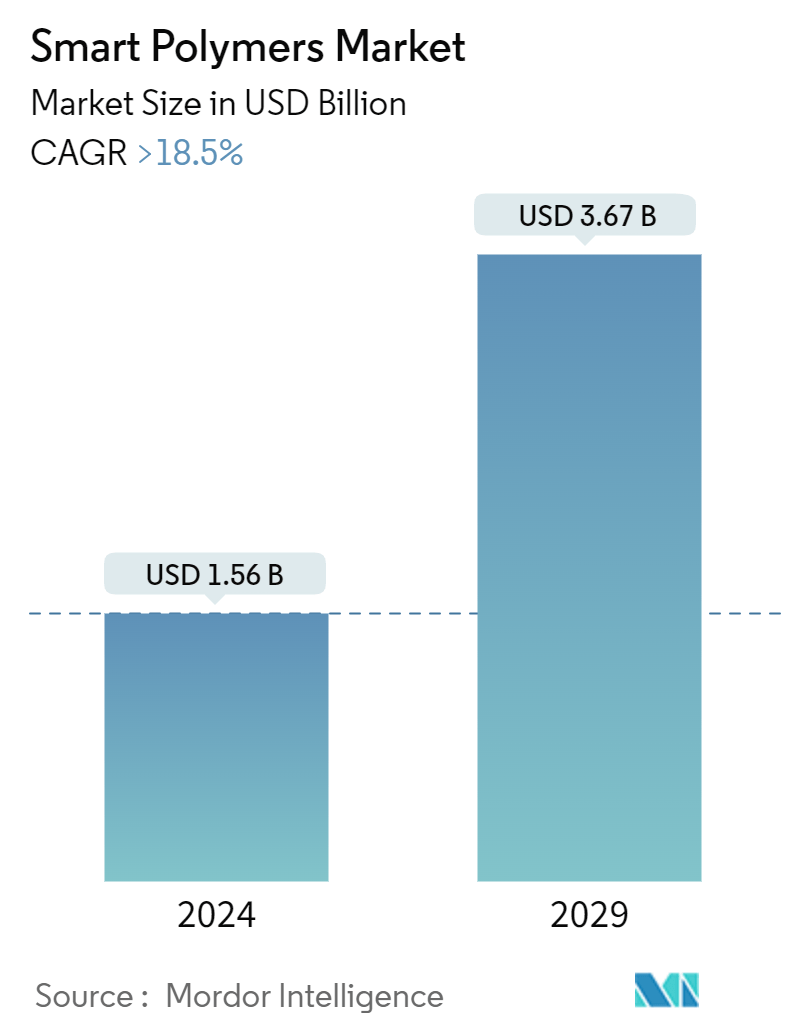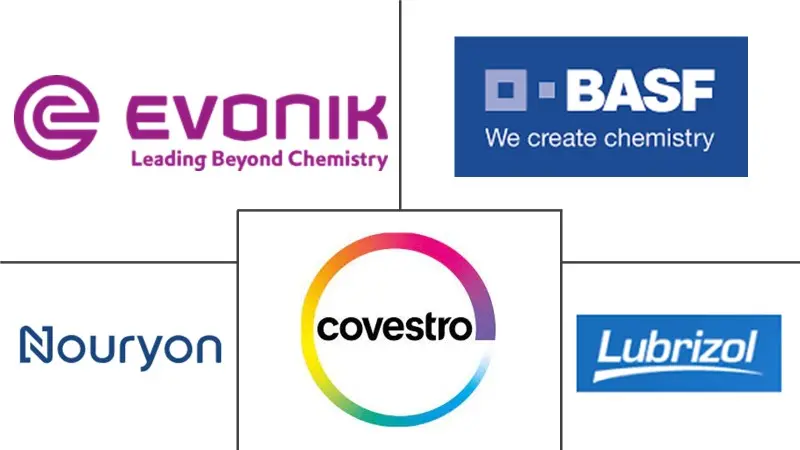
| Study Period | 2019 - 2029 |
| Market Size (2024) | USD 1.56 Billion |
| Market Size (2029) | USD 3.67 Billion |
| CAGR (2024 - 2029) | 18.50 % |
| Fastest Growing Market | Asia Pacific |
| Largest Market | North America |
| Market Concentration | Low |
Major Players
*Disclaimer: Major Players sorted in no particular order |
Smart Polymers Market Analysis
The Smart Polymers Market size is estimated at USD 1.56 billion in 2024, and is expected to reach USD 3.67 billion by 2029, growing at a CAGR of greater than 18.5% during the forecast period (2024-2029).
- The smart polymers market is experiencing dynamic advancements, driven by the growing demand for innovative applications across various industries. Smart polymers, also known as stimuli-responsive polymers, possess the unique ability to alter their properties in response to external stimuli such as temperature, light, pH, or electric fields. This adaptability positions them as valuable materials across diverse sectors, including healthcare, textiles, electronics, and automotive industries.
- Healthcare Applications: In the healthcare sector, smart polymers are increasingly utilized in drug delivery systems. These polymers are engineered to release therapeutic agents in response to specific stimuli, such as changes in pH or temperature, often present in diseased tissues. This capability ensures targeted delivery and improves treatment efficacy, significantly enhancing the effectiveness of chronic disease management. The development of biodegradable smart polymers is also gaining traction, as these materials degrade naturally within the body, eliminating the need for surgical removal and reducing long-term complications. The integration of smart polymer coatings in medical devices and implants further enhances their functionality and biocompatibility, preventing infections and improving patient outcomes.
- Textile Industry Innovations: The use of shape-memory polymers is revolutionizing the textile industry by enabling the creation of adaptive clothing that responds to environmental changes. For instance, thermo-responsive polymers allow garments to adjust their shape or texture in response to temperature fluctuations, providing enhanced comfort to the wearer. This innovation not only offers functional benefits but also aligns with the growing consumer demand for sustainable and long-lasting products, as these materials extend the lifespan of garments by adapting to changes in body size or shape.
- 3D Printing and Custom Manufacturing: The incorporation of smart polymers in 3D printing technologies is another significant trend driving the market. These polymers enable the production of complex structures that can respond to environmental changes, expanding the possibilities for custom manufacturing and advanced product design. The versatility of smart polymers in 3D printing allows for the creation of components with unique properties, such as self-healing or shape-memory, which are highly sought after in industries like aerospace and automotive.
- Despite the promising applications, the high cost of technology and development presents a significant challenge to the widespread adoption of smart polymers. Research and production of these materials require substantial investment, which can limit their accessibility, particularly in cost-sensitive markets.
Innovation in Drug Delivery: A Growing Application in Healthcare
- Targeted and Controlled Drug Release: The healthcare sector is increasingly adopting smart polymers for their ability to deliver drugs in a controlled and targeted manner. These polymers can be engineered to release therapeutic agents in response to specific stimuli, enhancing treatment efficacy while reducing side effects. This targeted approach minimizes the frequency of drug administration, offering significant benefits in managing chronic diseases. As the demand for personalized medicine grows, smart polymers are expected to see substantial market growth in healthcare applications.
- Biodegradable Smart Polymers: The development of biodegradable smart polymers is a significant innovation in the healthcare sector. These materials degrade naturally within the body after fulfilling their purpose, reducing the risk of long-term complications and eliminating the need for surgical removal. The environmental sustainability of biodegradable smart polymers also contributes to their growing demand, particularly as the healthcare industry moves towards greener and more sustainable practices.
- Smart Polymer Coatings: Innovations in smart polymer coatings are contributing to the growing adoption of these materials in medical devices and implants. These coatings can respond to biological signals, preventing the formation of biofilms or controlling the release of drugs directly from the surface of the implant. This technology is particularly valuable in preventing infections and improving the longevity and performance of medical devices.
Textile Industry Transformation: Shape Memory Polymers on the Rise
- Adaptive Clothing: The incorporation of shape-memory polymers into textiles is revolutionizing the industry by enabling the creation of adaptive clothing. These garments can respond to environmental conditions, such as temperature changes, by altering their shape or texture. For example, clothing made from thermo-responsive polymers can expand or contract to provide better insulation or ventilation as needed, offering enhanced comfort to the wearer.
- Functional and Fashion-Forward Textiles: Shape-memory polymers are also being used to create textiles that offer both functionality and aesthetic appeal. Designers are leveraging these materials to produce clothing that can change its appearance based on the wearer's needs or preferences, such as switching from casual to formal styles. This innovation is driving demand in both the fashion industry and sectors that require specialized clothing, such as outdoor gear and uniforms.
- Sustainability in Textiles: Beyond their functional benefits, shape-memory polymers contribute to sustainability in the textile industry. These materials can reduce waste by extending the life of garments through their adaptive properties, which can adjust to fit changes in body size or shape. This durability aligns with the growing consumer demand for sustainable and long-lasting products, further boosting the adoption of smart polymers in textiles.
The smart polymers market is poised for continued growth as innovations in healthcare, textiles, and 3D printing drive demand for these versatile materials. Despite the challenges posed by high costs, the benefits offered by smart polymers in various applications underscore their potential to transform industries and create new opportunities for advanced product development.
Smart Polymers Industry Segmentation
Smart polymers are adaptive and responsive to signals such as temperature, ionic strength, and many other applied fields. They are used in artificial muscle sensors and actuators, hydrogel processing, biodegradable packaging, and biomedical engineering.
The smart polymers market is segmented by type, end-user industry, and geography. By type, the market is segmented into physical stimuli-responsive, chemical stimuli-responsive, biological stimuli-responsive, self-healing polymers, and other types (thermally responsive, etc.). By end-user industry, the market is segmented into biomedical and healthcare, electrical and electronics, textile, automotive, and other end-user industries (agriculture, etc.). The report also covers the market size and forecasts for the market in 15 countries across the globe (Asia-Pacific, North America, Europe, South America, and Middle-East and Africa).
For each segment, the market sizing and forecasts have been done on the basis of value (USD).
| Physical Stimuli-responsive |
| Chemical Stimuli-responsive |
| Biological Stimuli-responsive |
| Self-healing Polymers |
| Other Types (Thermally Responsive, Etc.) |
| Biomedical and Healthcare |
| Electrical and Electronics |
| Textile |
| Automotive |
| Other End-user Industries (Agriculture, Etc.) |
| Asia-Pacific | China |
| India | |
| Japan | |
| South Korea | |
| Rest of Asia-Pacific | |
| North America | United States |
| Canada | |
| Mexico | |
| Europe | Germany |
| United Kingdom | |
| Italy | |
| France | |
| Rest of Europe | |
| South America | Brazil |
| Argentina | |
| Rest of South America | |
| Middle East and Africa | Saudi Arabia |
| South Africa | |
| Rest of Middle East and Africa |
Smart Polymers Market Size Summary
The smart polymers market is experiencing significant growth, driven by their increasing applications across various industries, particularly in healthcare and textiles. The market is characterized by the integration of smart polymers in innovative solutions such as shape memory polymers, smart biopolymers, and self-healing polymers. These materials are gaining traction due to their unique properties and functionalities, which are being leveraged in areas like drug delivery systems, tissue engineering, and 3D printing. Despite challenges such as high development costs, the market is poised for expansion, with opportunities emerging in regions like Latin America and the Middle East & Africa. North America remains a dominant player, fueled by robust demand in healthcare and automotive sectors.
The healthcare industry, in particular, is a major consumer of smart polymers, utilizing them in medical devices, pharmaceuticals, and advanced drug delivery systems. The ongoing growth in the biomedical sector is expected to further drive the demand for these materials. In North America, the United States leads the market due to its substantial healthcare spending and research initiatives. The region's automotive industry also contributes to the market's expansion, with smart polymers being used in various applications. The market is fragmented, with key players like Autonomic Materials, Evonik Industries AG, and Merck KGaA actively participating in innovation and strategic acquisitions to enhance their product offerings.
Smart Polymers Market Size - Table of Contents
1. MARKET DYNAMICS
-
1.1 Drivers
- 1.1.1 Increasing Application of Shape Memory Polymer in Textile Industry
- 1.1.2 Increasing Need for Efficient Drug Delivery System
- 1.1.3 Development of Smart Biopolymers
-
1.2 Restraints
- 1.2.1 High Cost of Technology and Development of Smart Polymers
- 1.2.2 Other Restraints
- 1.3 Industry Value Chain Analysis
-
1.4 Porter's Five Forces Analysis
- 1.4.1 Bargaining Power of Suppliers
- 1.4.2 Bargaining Power of Buyers
- 1.4.3 Threat of New Entrants
- 1.4.4 Threat of Substitute Products and Services
- 1.4.5 Degree of Competition
2. MARKET SEGMENTATION (Market Size in Value)
-
2.1 Type
- 2.1.1 Physical Stimuli-responsive
- 2.1.2 Chemical Stimuli-responsive
- 2.1.3 Biological Stimuli-responsive
- 2.1.4 Self-healing Polymers
- 2.1.5 Other Types (Thermally Responsive, Etc.)
-
2.2 End-user Industry
- 2.2.1 Biomedical and Healthcare
- 2.2.2 Electrical and Electronics
- 2.2.3 Textile
- 2.2.4 Automotive
- 2.2.5 Other End-user Industries (Agriculture, Etc.)
-
2.3 Geography
- 2.3.1 Asia-Pacific
- 2.3.1.1 China
- 2.3.1.2 India
- 2.3.1.3 Japan
- 2.3.1.4 South Korea
- 2.3.1.5 Rest of Asia-Pacific
- 2.3.2 North America
- 2.3.2.1 United States
- 2.3.2.2 Canada
- 2.3.2.3 Mexico
- 2.3.3 Europe
- 2.3.3.1 Germany
- 2.3.3.2 United Kingdom
- 2.3.3.3 Italy
- 2.3.3.4 France
- 2.3.3.5 Rest of Europe
- 2.3.4 South America
- 2.3.4.1 Brazil
- 2.3.4.2 Argentina
- 2.3.4.3 Rest of South America
- 2.3.5 Middle East and Africa
- 2.3.5.1 Saudi Arabia
- 2.3.5.2 South Africa
- 2.3.5.3 Rest of Middle East and Africa
Smart Polymers Market Research FAQs
How big is the Smart Polymers Market?
The Smart Polymers Market size is expected to reach USD 1.85 billion in 2025 and grow at a CAGR of greater than 18.5% to reach USD 4.32 billion by 2030.
What is the current Smart Polymers Market size?
In 2025, the Smart Polymers Market size is expected to reach USD 1.85 billion.


